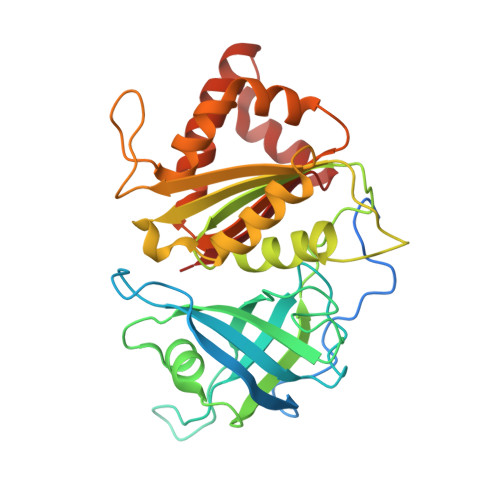Swapping Fad Binding Motifs between Plastidic and Bacterial Ferredoxin-Nadp(H) Reductases.
Musumeci, M.A., Botti, H., Buschiazzo, A., Ceccarelli, E.A.(2011) Biochemistry 50: 2111
- PubMed: 21306142
- DOI: https://doi.org/10.1021/bi101772a
- Primary Citation of Related Structures:
2XNC, 2XNJ - PubMed Abstract:
Plant-type ferredoxin-NADP(H) reductases (FNRs) are grouped in two classes, plastidic with an extended FAD conformation and high catalytic rates and bacterial with a folded flavin nucleotide and low turnover rates. The 112-123 β-hairpin from a plastidic FNR and the carboxy-terminal tryptophan of a bacterial FNR, suggested to be responsible for the FAD differential conformation, were mutually exchanged. The plastidic FNR lacking the β-hairpin was unable to fold properly. An extra tryptophan at the carboxy terminus, emulating the bacterial FNR, resulted in an enzyme with decreased affinity for FAD and reduced diaphorase and ferredoxin-dependent cytochrome c reductase activities. The insertion of the β-hairpin into the corresponding position of the bacterial FNR increased FAD affinity but did not affect its catalytic properties. The same insertion with simultaneous deletion of the carboxy-terminal tryptophan produced a bacterial chimera emulating the plastidic architecture with an increased k(cat) and an increased catalytic efficiency for the diaphorase activity and a decrease in the enzyme's ability to react with its substrates ferredoxin and flavodoxin. Crystallographic structures of the chimeras showed no significant changes in their overall structure, although alterations in the FAD conformations were observed. Plastidic and bacterial FNRs thus reveal differential effects of key structural elements. While the 112-123 β-hairpin modulates the catalytic efficiency of plastidic FNR, it seems not to affect the bacterial FNR behavior, which instead can be improved by the loss of the C-terminal tryptophan. This report highlights the role of the FAD moiety conformation and the structural determinants involved in stabilizing it, ultimately modulating the functional output of FNRs.
Organizational Affiliation:
Molecular Biology Division, Instituto de Biología Molecular y Celular de Rosario (IBR), CONICET, Facultad de Ciencias Bioquímicas y Farmacéuticas, Universidad Nacional de Rosario, Suipacha 531, S2002LRK Rosario, Argentina.
















